instrument panel TOYOTA AYGO 2021 Owners Manual
[x] Cancel search | Manufacturer: TOYOTA, Model Year: 2021, Model line: AYGO, Model: TOYOTA AYGO 2021Pages: 546, PDF Size: 81 MB
Page 16 of 546
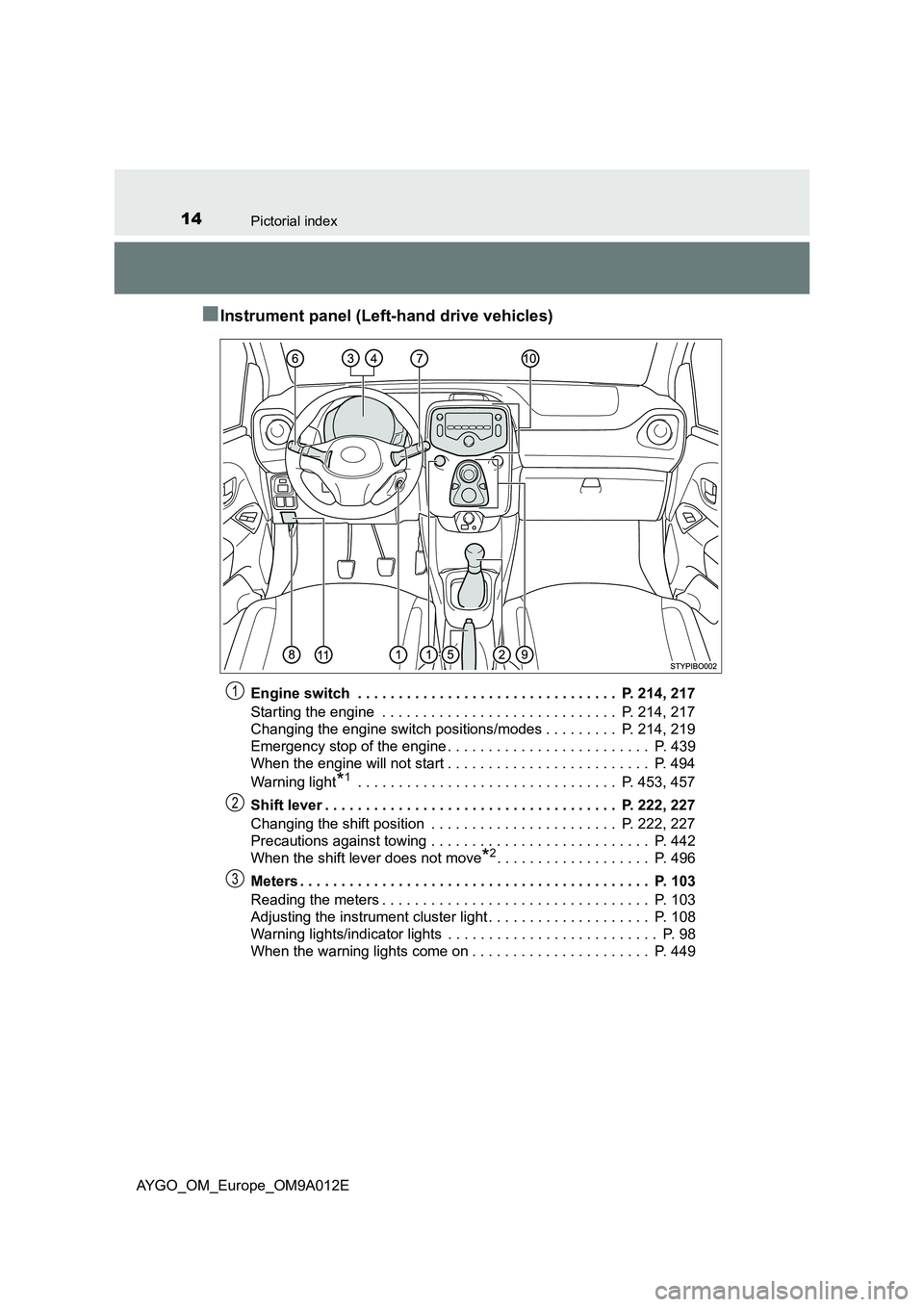
14Pictorial index
AYGO_OM_Europe_OM9A012E
■Instrument panel (Left-hand drive vehicles)
Engine switch . . . . . . . . . . . . . . . . . . . . . . . . . . . . . . . . P. 214, 217
Starting the engine . . . . . . . . . . . . . . . . . . . . . . . . . . . . . P. 214, 217
Changing the engine switch positions/modes . . . . . . . . . P. 214, 219
Emergency stop of the engine . . . . . . . . . . . . . . . . . . . . . . . . . P. 439
When the engine will not start . . . . . . . . . . . . . . . . . . . . . . . . . P. 494
Warning light
*1 . . . . . . . . . . . . . . . . . . . . . . . . . . . . . . . . P. 453, 457
Shift lever . . . . . . . . . . . . . . . . . . . . . . . . . . . . . . . . . . . . P. 222, 227
Changing the shift position . . . . . . . . . . . . . . . . . . . . . . . P. 222, 227
Precautions against towing . . . . . . . . . . . . . . . . . . . . . . . . . . . P. 442
When the shift lever does not move
*2. . . . . . . . . . . . . . . . . . . P. 496
Meters . . . . . . . . . . . . . . . . . . . . . . . . . . . . . . . . . . . . . . . . . . . P. 103
Reading the meters . . . . . . . . . . . . . . . . . . . . . . . . . . . . . . . . . P. 103
Adjusting the instrument cluster light . . . . . . . . . . . . . . . . . . . . P. 108
Warning lights/indicator lights . . . . . . . . . . . . . . . . . . . . . . . . . . P. 98
When the warning lights come on . . . . . . . . . . . . . . . . . . . . . . P. 449
1
2
3
Page 22 of 546
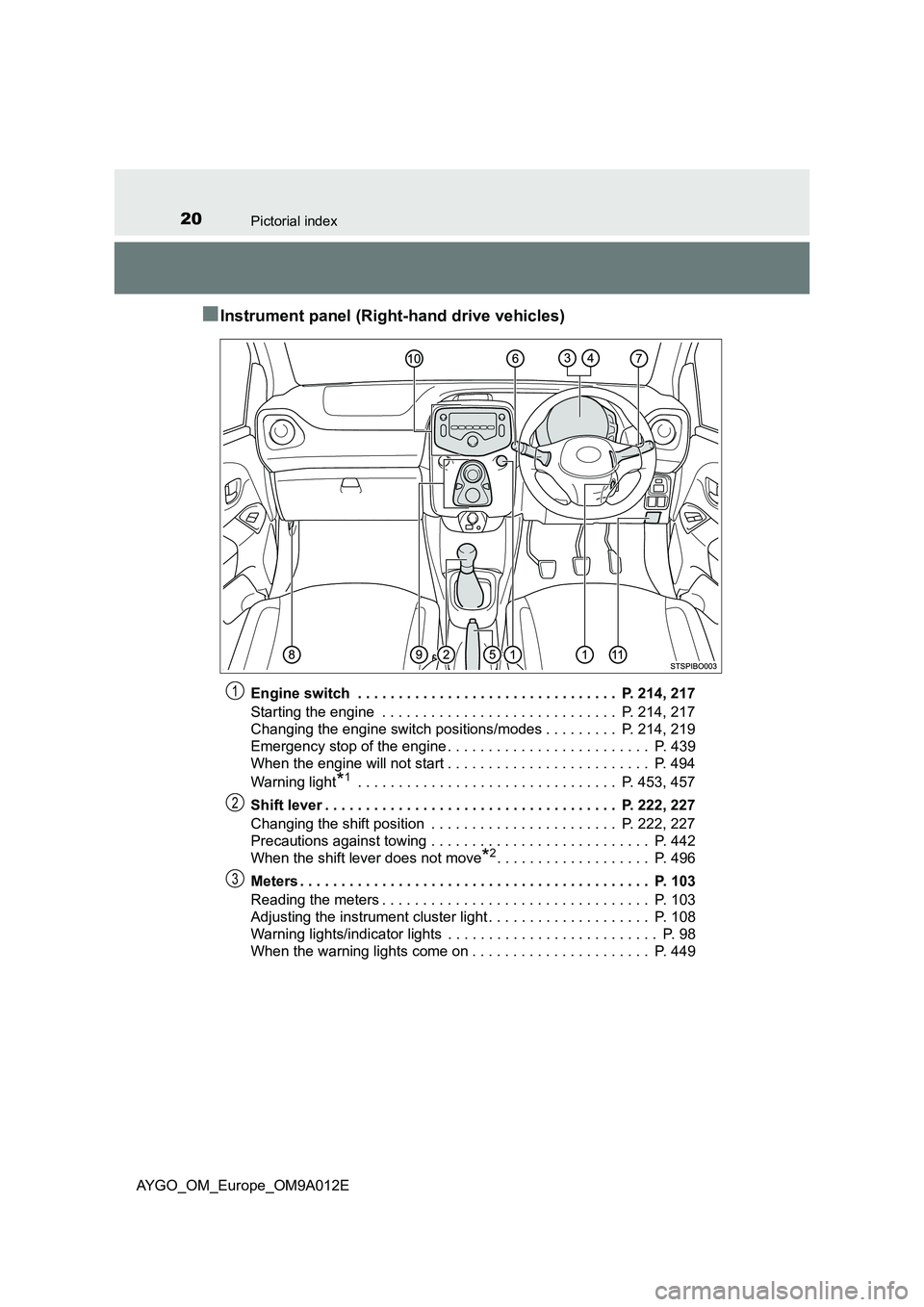
20Pictorial index
AYGO_OM_Europe_OM9A012E
■Instrument panel (Right-hand drive vehicles)
Engine switch . . . . . . . . . . . . . . . . . . . . . . . . . . . . . . . . P. 214, 217
Starting the engine . . . . . . . . . . . . . . . . . . . . . . . . . . . . . P. 214, 217
Changing the engine switch positions/modes . . . . . . . . . P. 214, 219
Emergency stop of the engine . . . . . . . . . . . . . . . . . . . . . . . . . P. 439
When the engine will not start . . . . . . . . . . . . . . . . . . . . . . . . . P. 494
Warning light
*1 . . . . . . . . . . . . . . . . . . . . . . . . . . . . . . . . P. 453, 457
Shift lever . . . . . . . . . . . . . . . . . . . . . . . . . . . . . . . . . . . . P. 222, 227
Changing the shift position . . . . . . . . . . . . . . . . . . . . . . . P. 222, 227
Precautions against towing . . . . . . . . . . . . . . . . . . . . . . . . . . . P. 442
When the shift lever does not move
*2. . . . . . . . . . . . . . . . . . . P. 496
Meters . . . . . . . . . . . . . . . . . . . . . . . . . . . . . . . . . . . . . . . . . . . P. 103
Reading the meters . . . . . . . . . . . . . . . . . . . . . . . . . . . . . . . . . P. 103
Adjusting the instrument cluster light . . . . . . . . . . . . . . . . . . . . P. 108
Warning lights/indicator lights . . . . . . . . . . . . . . . . . . . . . . . . . . P. 98
When the warning lights come on . . . . . . . . . . . . . . . . . . . . . . P. 449
1
2
3
Page 44 of 546
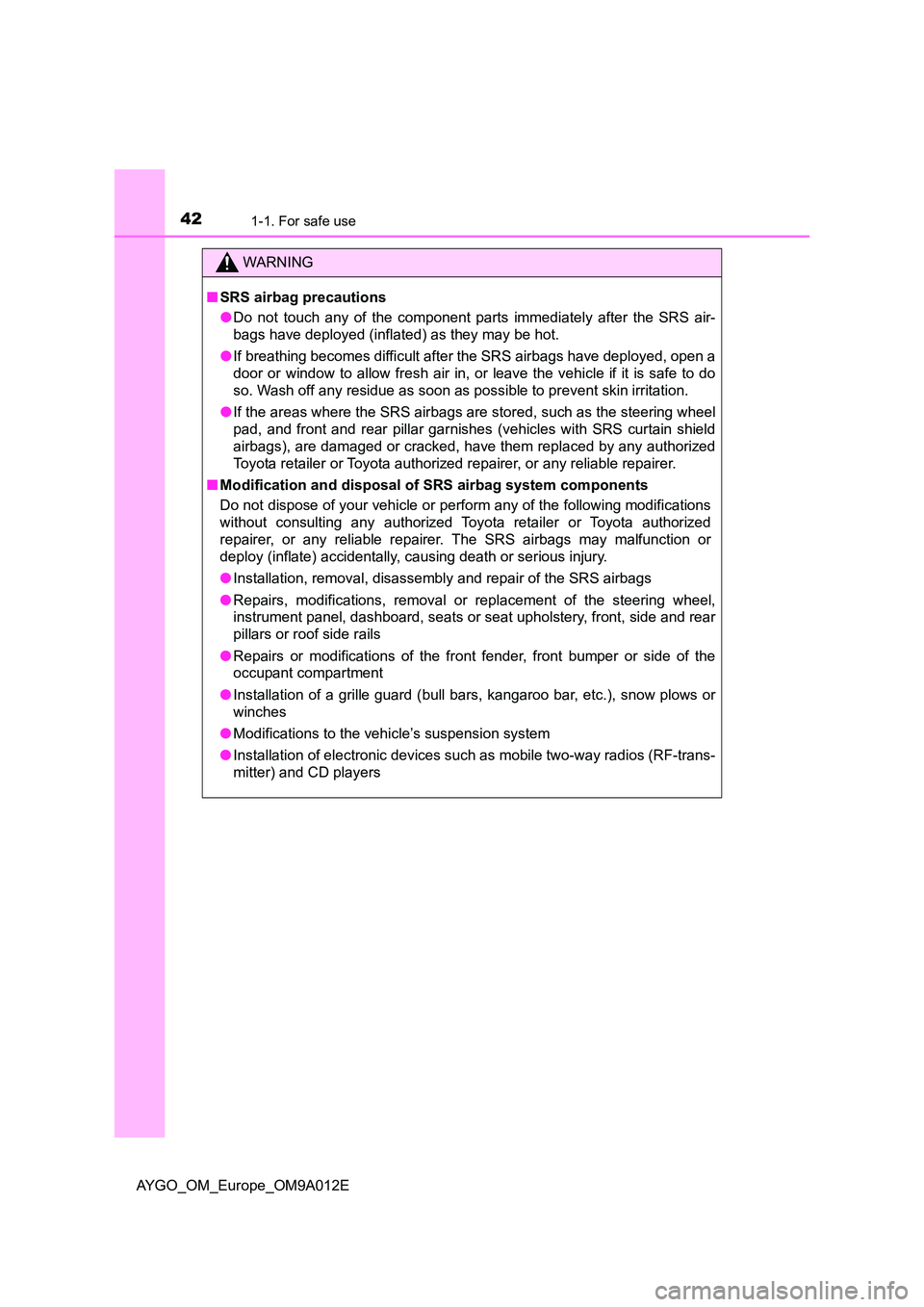
421-1. For safe use
AYGO_OM_Europe_OM9A012E
WARNING
■SRS airbag precautions
● Do not touch any of the component parts immediately after the SRS air-
bags have deployed (inflated) as they may be hot.
● If breathing becomes difficult after the SRS airbags have deployed, open a
door or window to allow fresh air in, or leave the vehicle if it is safe to do
so. Wash off any residue as soon as possible to prevent skin irritation.
● If the areas where the SRS airbags are stored, such as the steering wheel
pad, and front and rear pillar garnishes (vehicles with SRS curtain shield
airbags), are damaged or cracked, have them replaced by any authorized
Toyota retailer or Toyota authorized repairer, or any reliable repairer.
■ Modification and disposal of SRS airbag system components
Do not dispose of your vehicle or perform any of the following modifications
without consulting any authorized Toyota retailer or Toyota authorized
repairer, or any reliable repairer. The SRS airbags may malfunction or
deploy (inflate) accidentally, causing death or serious injury.
● Installation, removal, disassembly and repair of the SRS airbags
● Repairs, modifications, removal or replacement of the steering wheel,
instrument panel, dashboard, seats or seat upholstery, front, side and rear
pillars or roof side rails
● Repairs or modifications of the front fender, front bumper or side of the
occupant compartment
● Installation of a grille guard (bull bars, kangaroo bar, etc.), snow plows or
winches
● Modifications to the vehicle’s suspension system
● Installation of electronic devices such as mobile two-way radios (RF-trans-
mitter) and CD players
Page 100 of 546
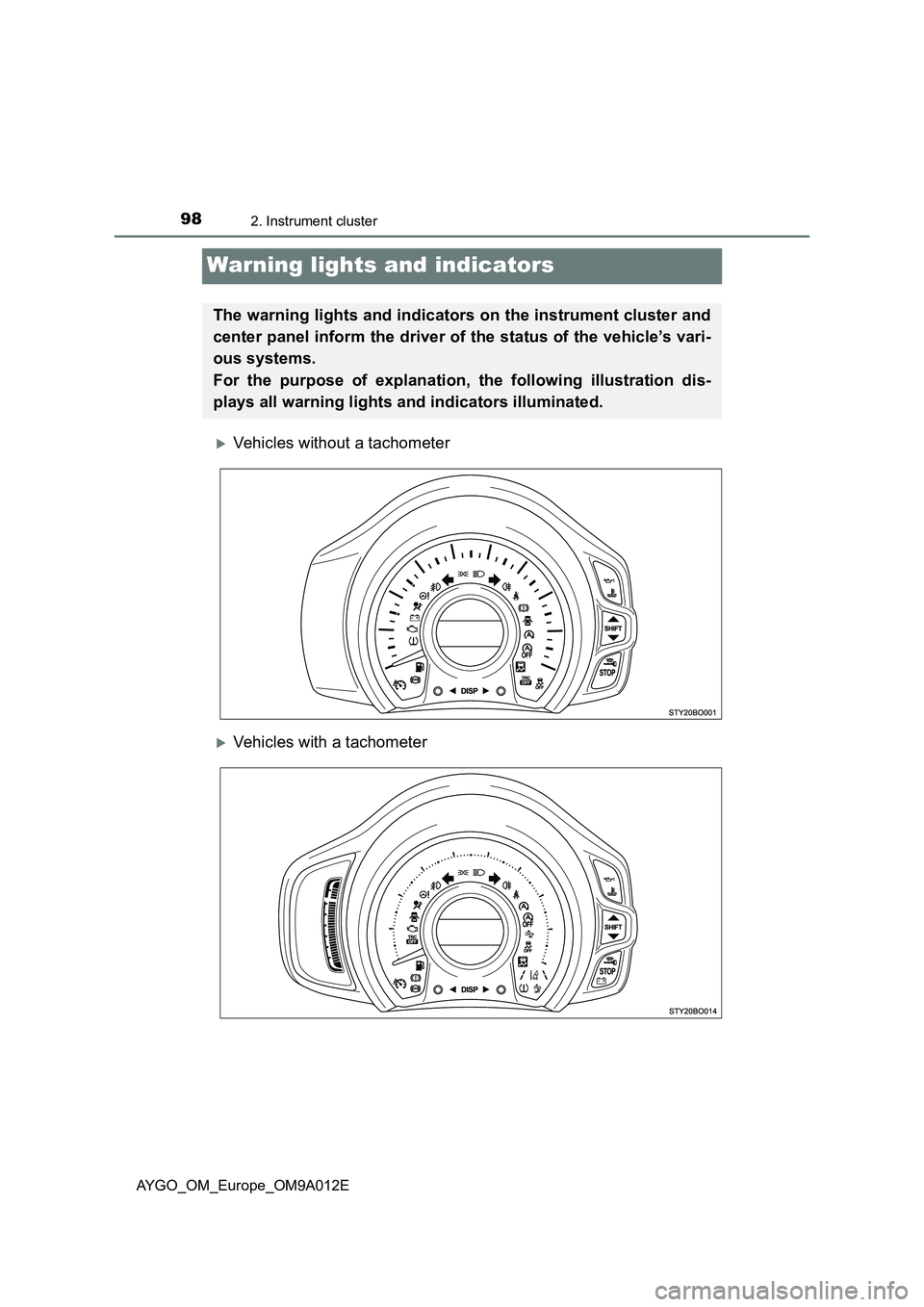
982. Instrument cluster
AYGO_OM_Europe_OM9A012E
Warning lights and indicators
Vehicles without a tachometer
Vehicles with a tachometer
The warning lights and indicators on the instrument cluster and
center panel inform the driver of the status of the vehicle’s vari-
ous systems.
For the purpose of explanation, the following illustration dis-
plays all warning lights and indicators illuminated.
Page 102 of 546
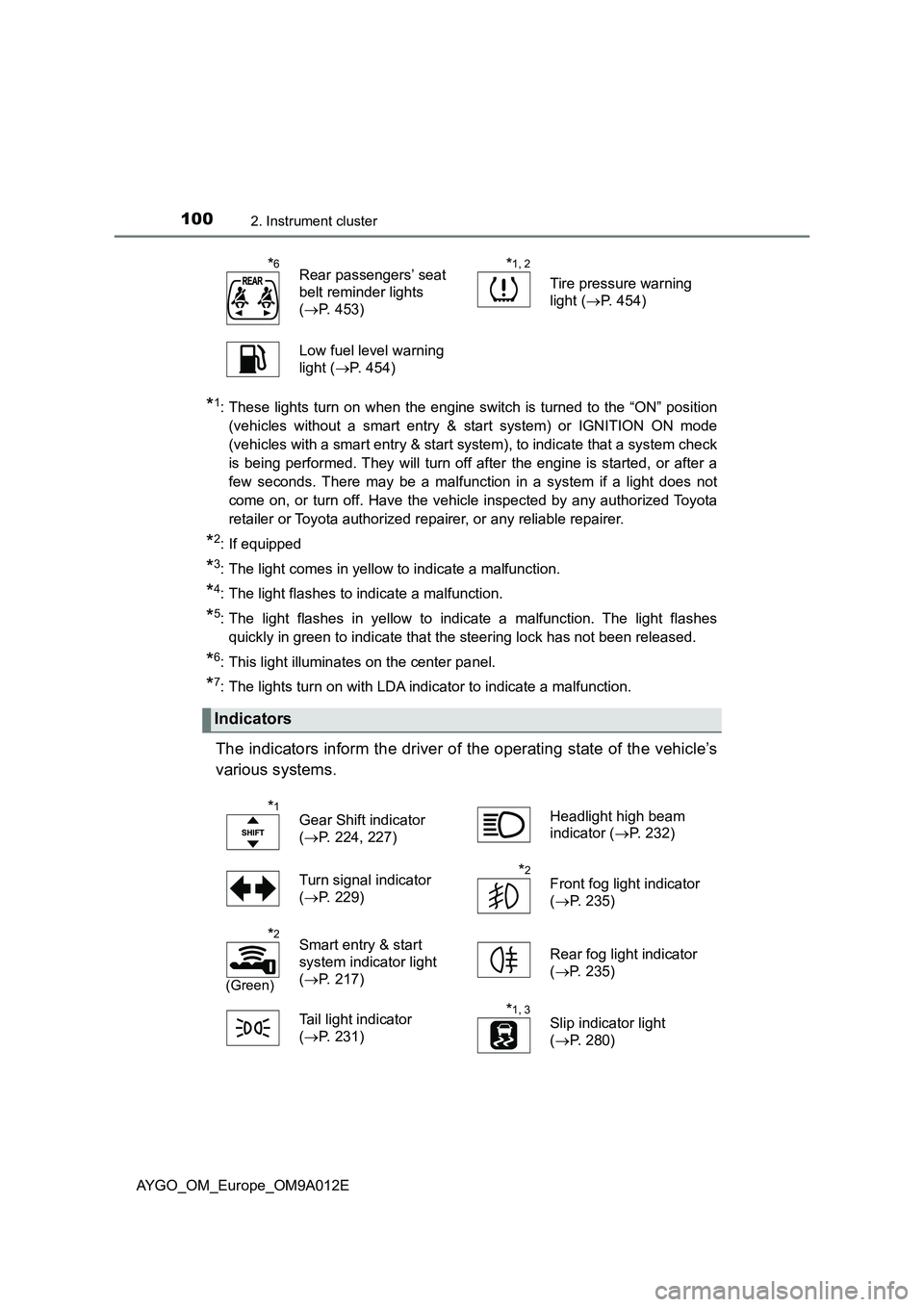
1002. Instrument cluster
AYGO_OM_Europe_OM9A012E
*1: These lights turn on when the engine switch is turned to the “ON” position
(vehicles without a smart entry & start system) or IGNITION ON mode
(vehicles with a smart entry & start system), to indicate that a system check
is being performed. They will turn off after the engine is started, or after a
few seconds. There may be a malfunction in a system if a light does not
come on, or turn off. Have the vehicle inspected by any authorized Toyota
retailer or Toyota authorized repairer, or any reliable repairer.
*2: If equipped
*3: The light comes in yellow to indicate a malfunction.
*4: The light flashes to indicate a malfunction.
*5: The light flashes in yellow to indicate a malfunction. The light flashes
quickly in green to indicate that the steering lock has not been released.
*6: This light illuminates on the center panel.
*7: The lights turn on with LDA indicator to indicate a malfunction.
The indicators inform the driver of the operating state of the vehicle’s
various systems.
*6Rear passengers’ seat
belt reminder lights
(P. 453)*1, 2
Tire pressure warning
light (P. 454)
Low fuel level warning
light (P. 454)
Indicators
*1Gear Shift indicator
(P. 224, 227)Headlight high beam
indicator (P. 232)
Turn signal indicator
(P. 229)
*2Front fog light indicator
(P. 235)
*2
(Green)
Smart entry & start
system indicator light
(P. 217)Rear fog light indicator
(P. 235)
Tail light indicator
(P. 231)
*1, 3Slip indicator light
(P. 280)
Page 103 of 546
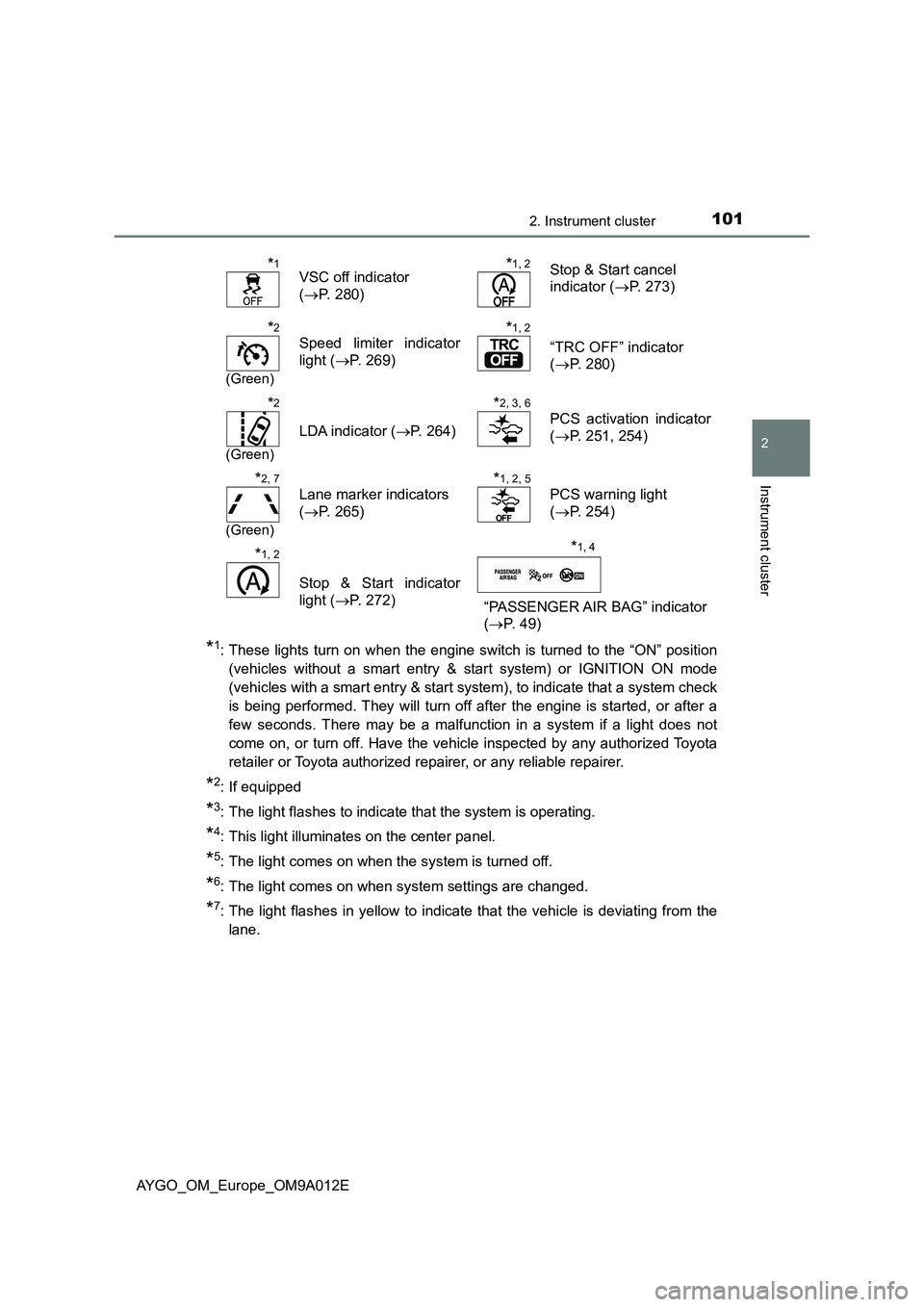
1012. Instrument cluster
2
Instrument cluster
AYGO_OM_Europe_OM9A012E
*1: These lights turn on when the engine switch is turned to the “ON” position
(vehicles without a smart entry & start system) or IGNITION ON mode
(vehicles with a smart entry & start system), to indicate that a system check
is being performed. They will turn off after the engine is started, or after a
few seconds. There may be a malfunction in a system if a light does not
come on, or turn off. Have the vehicle inspected by any authorized Toyota
retailer or Toyota authorized repairer, or any reliable repairer.
*2: If equipped
*3: The light flashes to indicate that the system is operating.
*4: This light illuminates on the center panel.
*5: The light comes on when the system is turned off.
*6: The light comes on when system settings are changed.
*7: The light flashes in yellow to indicate that the vehicle is deviating from the
lane.
*1VSC off indicator
( P. 280)
*1, 2Stop & Start cancel
indicator ( P. 273)
*2
(Green)
Speed limiter indicator
light ( P. 269)
*1, 2
“TRC OFF” indicator
( P. 280)
*2
(Green)
LDA indicator (P. 264)
*2, 3, 6
PCS activation indicator
( P. 251, 254)
*2, 7
(Green)
Lane marker indicators
( P. 265)
*1, 2, 5
PCS warning light
( P. 254)
*1, 2
Stop & Start indicator
light ( P. 272) “PASSENGER AIR BAG” indicator
( P. 4 9 )
*1, 4
Page 149 of 546
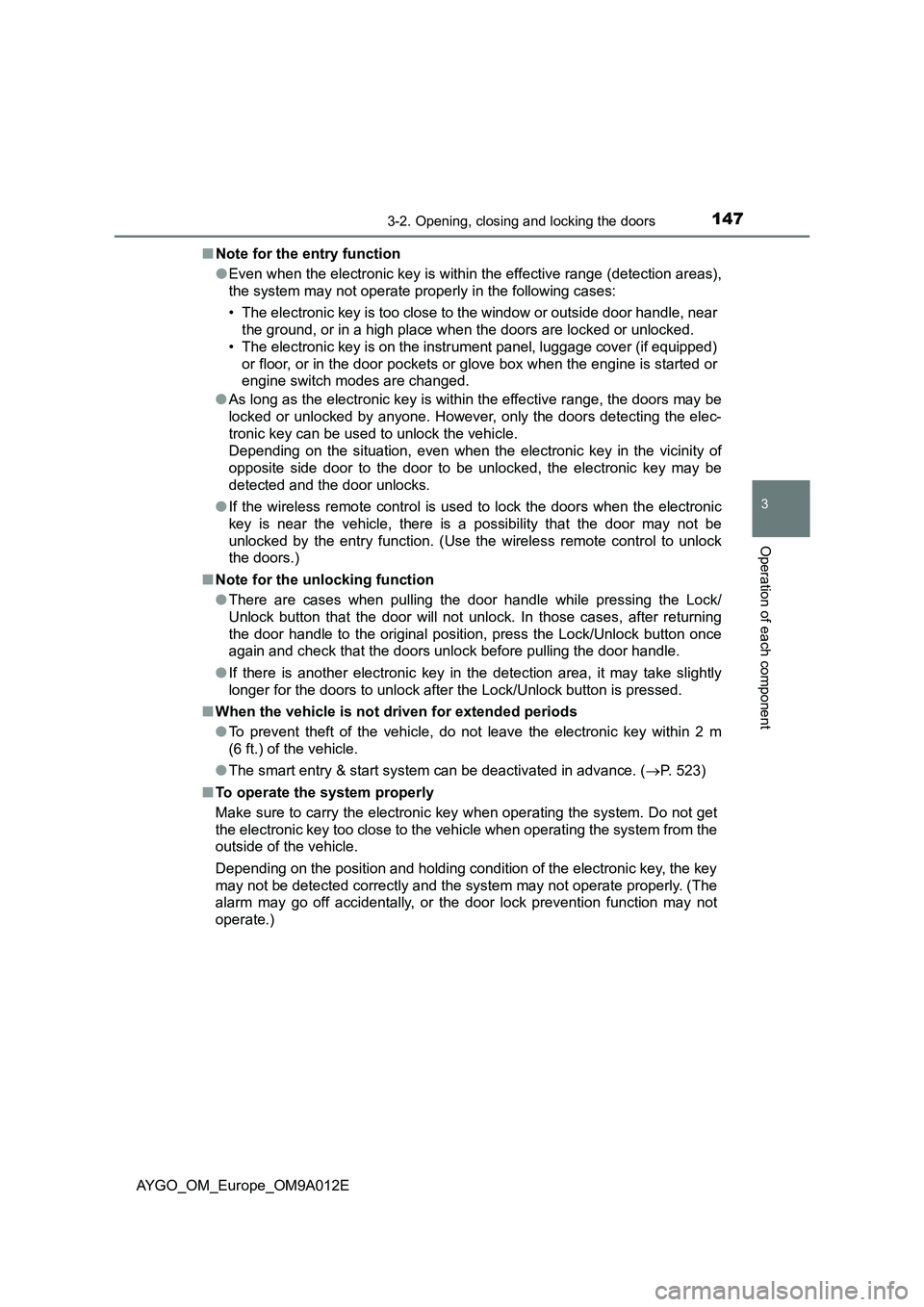
1473-2. Opening, closing and locking the doors
3
Operation of each component
AYGO_OM_Europe_OM9A012E■Note for the entry function
●Even when the electronic key is within the effective range (detection areas),
the system may not operate properly in the following cases:
• The electronic key is too close to the window or outside door handle, near
the ground, or in a high place when the doors are locked or unlocked.
• The electronic key is on the instrument panel, luggage cover (if equipped)
or floor, or in the door pockets or glove box when the engine is started or
engine switch modes are changed.
●As long as the electronic key is within the effective range, the doors may be
locked or unlocked by anyone. However, only the doors detecting the elec-
tronic key can be used to unlock the vehicle.
Depending on the situation, even when the electronic key in the vicinity of
opposite side door to the door to be unlocked, the electronic key may be
detected and the door unlocks.
●If the wireless remote control is used to lock the doors when the electronic
key is near the vehicle, there is a possibility that the door may not be
unlocked by the entry function. (Use the wireless remote control to unlock
the doors.)
■Note for the unlocking function
●There are cases when pulling the door handle while pressing the Lock/
Unlock button that the door will not unlock. In those cases, after returning
the door handle to the original position, press the Lock/Unlock button once
again and check that the doors unlock before pulling the door handle.
●If there is another electronic key in the detection area, it may take slightly
longer for the doors to unlock after the Lock/Unlock button is pressed.
■When the vehicle is not driven for extended periods
●To prevent theft of the vehicle, do not leave the electronic key within 2 m
(6 ft.) of the vehicle.
●The smart entry & start system can be deactivated in advance. (P. 523)
■To operate the system properly
Make sure to carry the electronic key when operating the system. Do not get
the electronic key too close to the vehicle when operating the system from the
outside of the vehicle.
Depending on the position and holding condition of the electronic key, the key
may not be detected correctly and the system may not operate properly. (The
alarm may go off accidentally, or the door lock prevention function may not
operate.)
Page 210 of 546
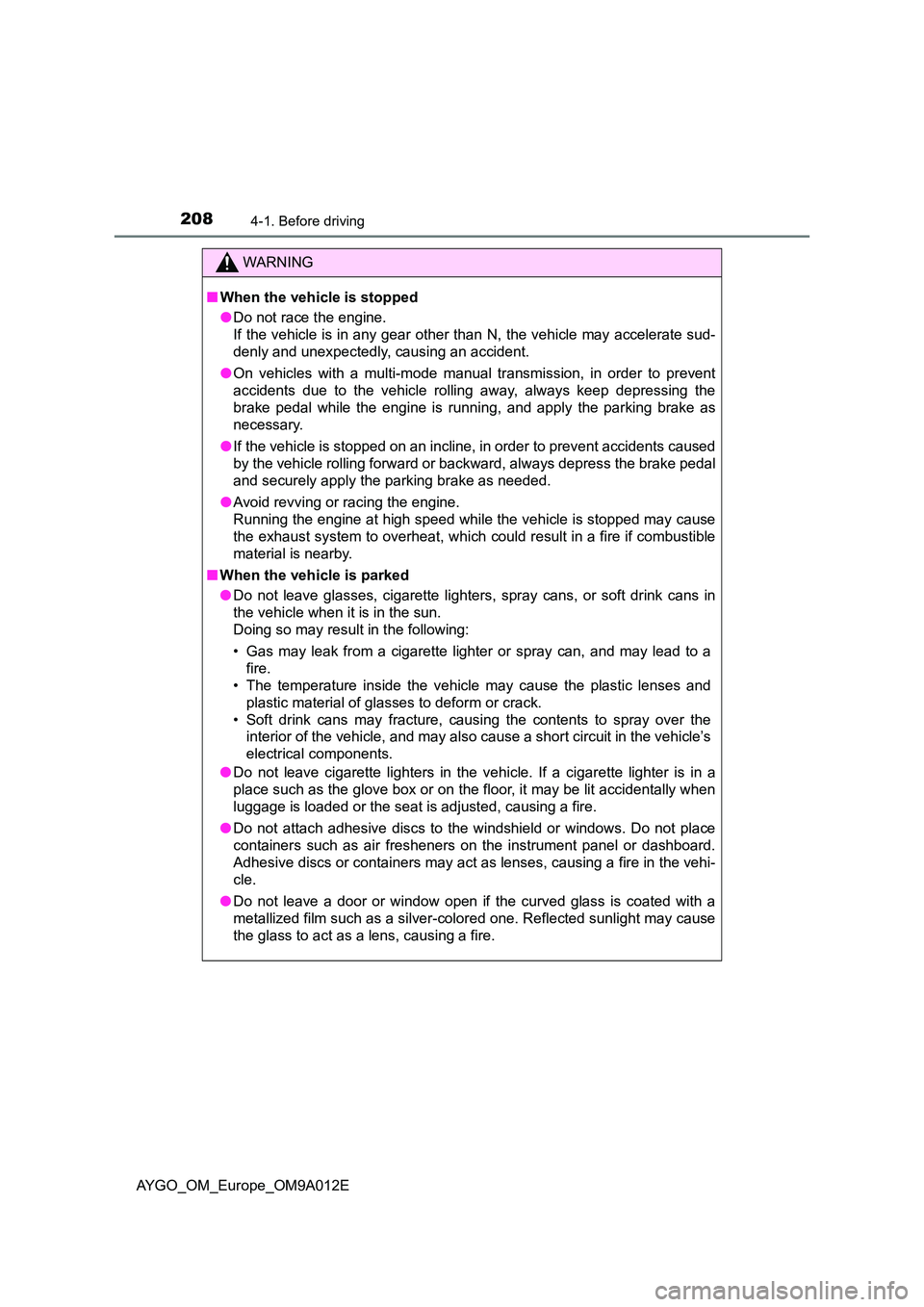
2084-1. Before driving
AYGO_OM_Europe_OM9A012E
WARNING
■When the vehicle is stopped
● Do not race the engine.
If the vehicle is in any gear other than N, the vehicle may accelerate sud-
denly and unexpectedly, causing an accident.
● On vehicles with a multi-mode manual transmission, in order to prevent
accidents due to the vehicle rolling away, always keep depressing the
brake pedal while the engine is running, and apply the parking brake as
necessary.
● If the vehicle is stopped on an incline, in order to prevent accidents caused
by the vehicle rolling forward or backward, always depress the brake pedal
and securely apply the parking brake as needed.
● Avoid revving or racing the engine.
Running the engine at high speed while the vehicle is stopped may cause
the exhaust system to overheat, which could result in a fire if combustible
material is nearby.
■ When the vehicle is parked
● Do not leave glasses, cigarette lighters, spray cans, or soft drink cans in
the vehicle when it is in the sun.
Doing so may result in the following:
• Gas may leak from a cigarette lighter or spray can, and may lead to a
fire.
• The temperature inside the vehicle may cause the plastic lenses and
plastic material of glasses to deform or crack.
• Soft drink cans may fracture, causing the contents to spray over the
interior of the vehicle, and may also cause a short circuit in the vehicle’s
electrical components.
● Do not leave cigarette lighters in the vehicle. If a cigarette lighter is in a
place such as the glove box or on the floor, it may be lit accidentally when
luggage is loaded or the seat is adjusted, causing a fire.
● Do not attach adhesive discs to the windshield or windows. Do not place
containers such as air fresheners on the instrument panel or dashboard.
Adhesive discs or containers may act as lenses, causing a fire in the vehi-
cle.
● Do not leave a door or window open if the curved glass is coated with a
metallized film such as a silver-colored one. Reflected sunlight may cause
the glass to act as a lens, causing a fire.
Page 214 of 546
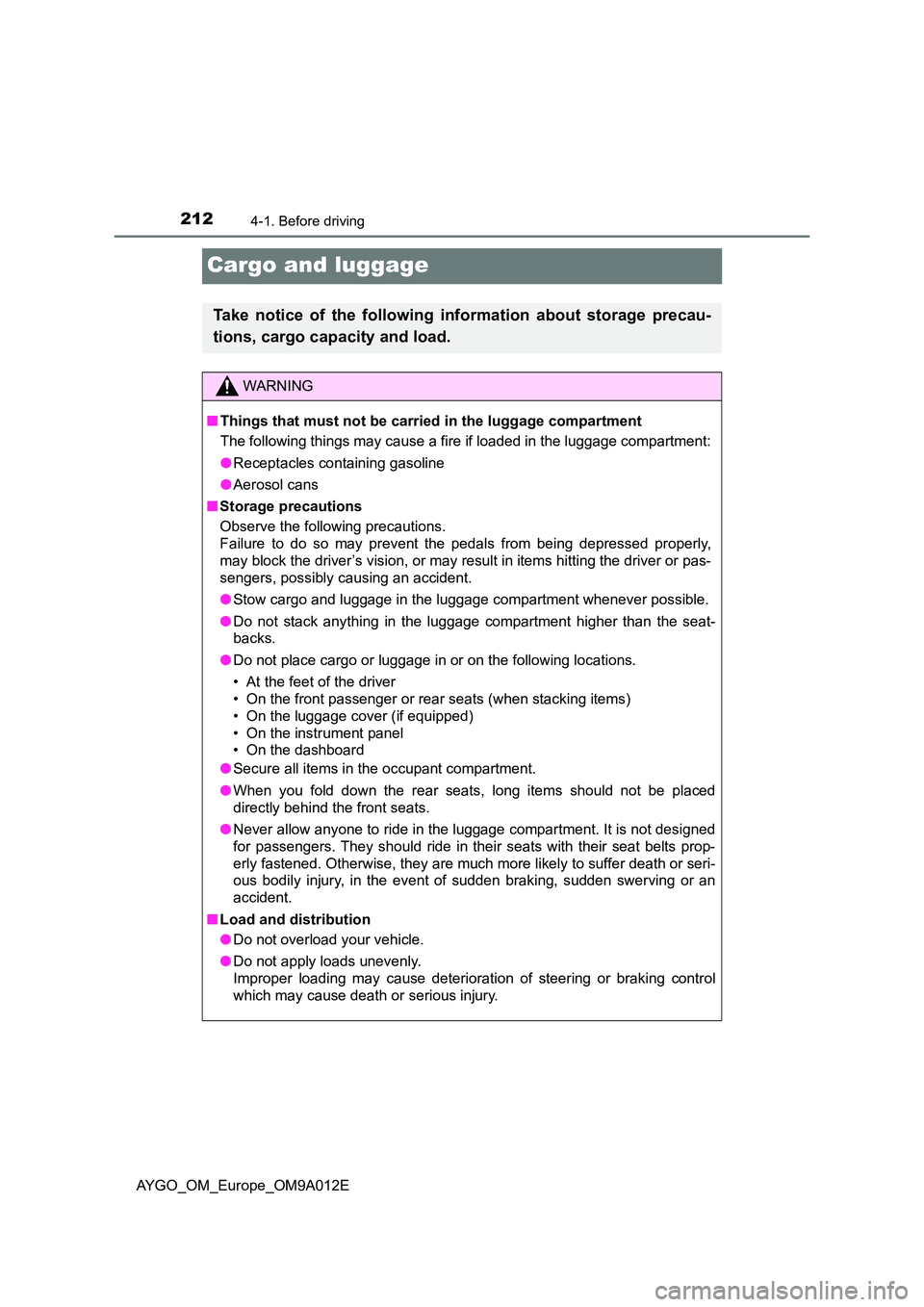
2124-1. Before driving
AYGO_OM_Europe_OM9A012E
Cargo and luggage
Take notice of the following information about storage precau-
tions, cargo capacity and load.
WARNING
■ Things that must not be carried in the luggage compartment
The following things may cause a fire if loaded in the luggage compartment:
● Receptacles containing gasoline
● Aerosol cans
■ Storage precautions
Observe the following precautions.
Failure to do so may prevent t he pedals from being depressed properly,
may block the driver’s vision, or may re sult in items hitting the driver or pas-
sengers, possibly causing an accident.
● Stow cargo and luggage in the luggage compartment whenever possible.
● Do not stack anything in the luggage compartment higher than the seat-
backs.
● Do not place cargo or luggage in or on the following locations.
• At the feet of the driver
• On the front passenger or rear seats (when stacking items)
• On the luggage cover (if equipped)
• On the instrument panel
• On the dashboard
● Secure all items in the occupant compartment.
● When you fold down the rear seats, long items should not be placed
directly behind the front seats.
● Never allow anyone to ride in the luggage compartment. It is not designed
for passengers. They should ride in their seats with their seat belts prop-
erly fastened. Otherwise, they are much more likely to suffer death or seri-
ous bodily injury, in the event of sudden braking, sudden swerving or an
accident.
■ Load and distribution
● Do not overload your vehicle.
● Do not apply loads unevenly.
Improper loading may cause deterioration of steering or braking control
which may cause death or serious injury.
Page 359 of 546
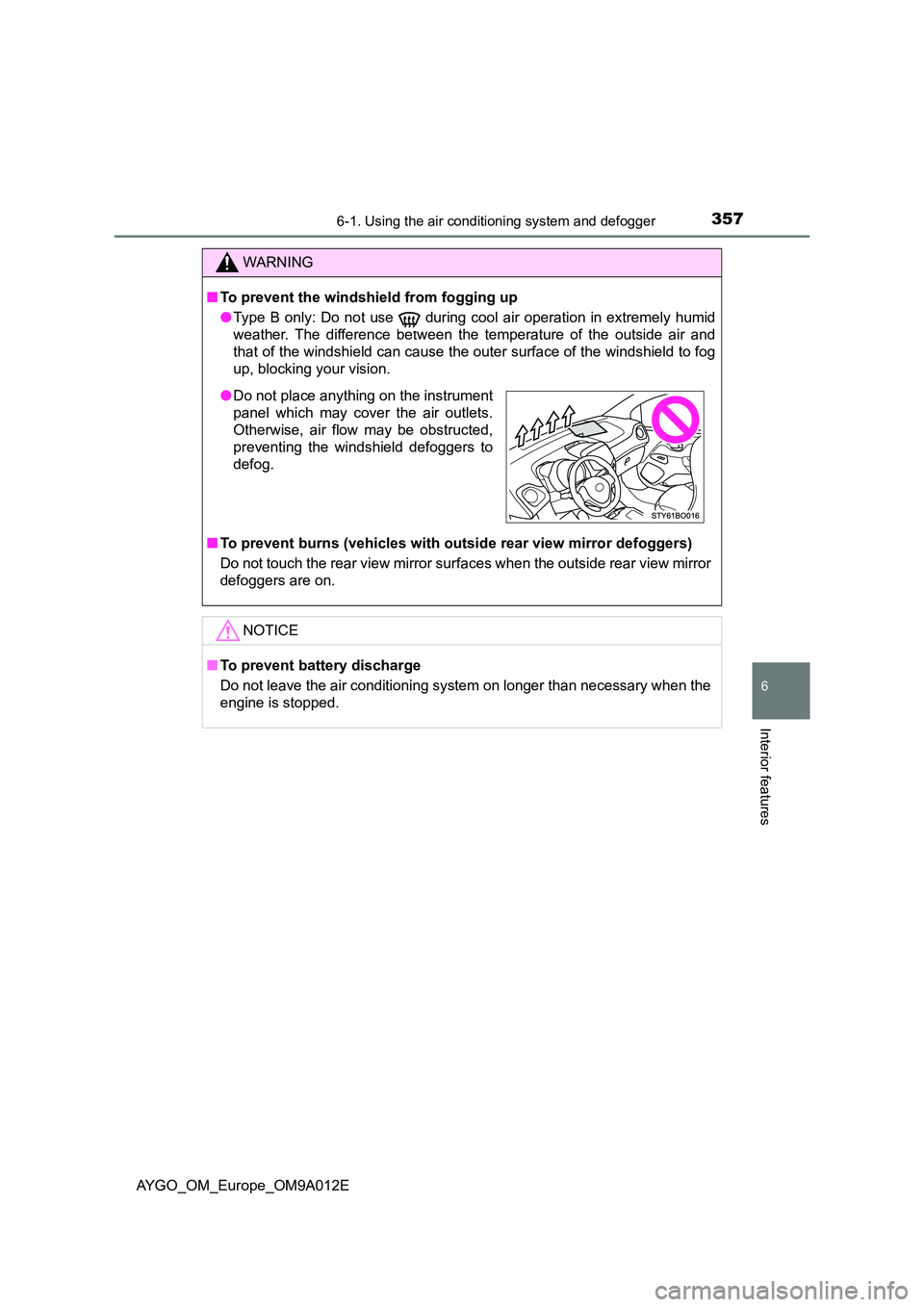
3576-1. Using the air conditioning system and defogger
6
Interior features
AYGO_OM_Europe_OM9A012E
WARNING
■To prevent the windshield from fogging up
● Type B only: Do not use during cool air operation in extremely humid
weather. The difference between the temperature of the outside air and
that of the windshield can cause the outer surface of the windshield to fog
up, blocking your vision.
■ To prevent burns (vehicles with outside rear view mirror defoggers)
Do not touch the rear view mirror surfaces when the outside rear view mirror
defoggers are on.
NOTICE
■ To prevent battery discharge
Do not leave the air conditioning syst em on longer than necessary when the
engine is stopped.
● Do not place anything on the instrument
panel which may cover the air outlets.
Otherwise, air flow may be obstructed,
preventing the windshield defoggers to
defog.